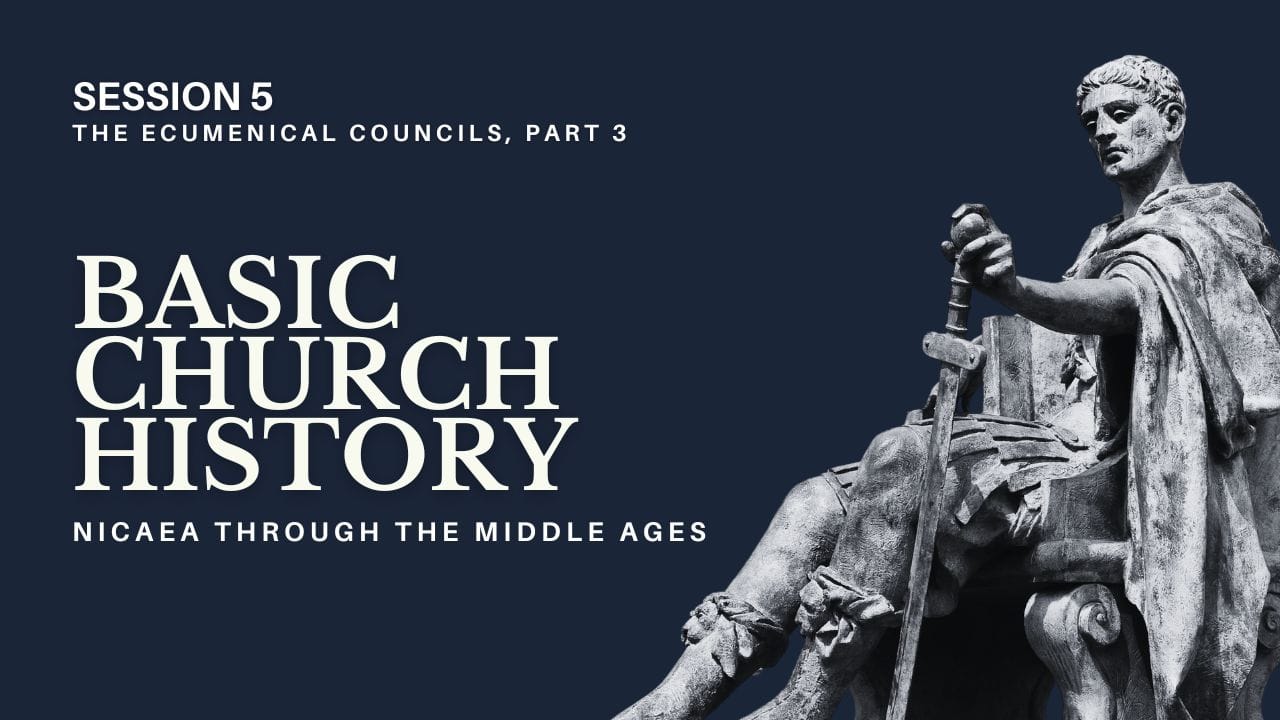Sunday School Review: Basic Church History: Nicaea through the Middle Ages, Part 5
Welcome to today’s review of the material covered in our fifth session: the four remaining great ecumenical councils.

Intense theological debates marked the early centuries of Christianity, a testament to the intellectual rigor of the church as it sought to clarify the nature of Christ, the Trinity, and the proper forms of worship. These debates, at their core, represented a pursuit of orthodoxy—a faithful expression of biblical truth capable of protecting the faithful from heresy. The great ecumenical councils, and the doctrinal clarity they provided, stand as evidence of the church's intellectual perseverance in defense of the truth, a legacy that continues to inspire the church today.
If you’re new here and missed last week's review, you can find it here.
The Council of Chalcedon (451 AD)
The Council of Chalcedon, held in 451 AD, convened to address the rise of Eutychianism, also known as Monophysitism, a doctrine that taught Christ had only one nature. Eutyches proposed that after the Incarnation, Christ's divine nature absorbed His human nature, leaving only a single, divine nature. However, this teaching contradicted the Bible's teaching of Christ being fully God and fully man together in one person.
After prayerful deliberation, the council produced what we know as the Chalcedonian Definition, carefully describing Christ's divine and human natures. According to this definition, Christ is to be acknowledged in two "natures, "without confusion, without change, without division, without separation." The Chalcedonian Definition preserved the distinction between Christ's divine and human natures while affirming they exist fully and perfectly in one person.
Interestingly, Pope Leo I (Leo the Great) was pivotal in crafting this response. His Tome of Leo, sent to the council, contended that Christ's two natures—divine and human—were united in one person but remained unconfused. The council's acclamation, "Peter has spoken through Leo," signaled the overwhelming acceptance of Leo's orthodox Christology (teaching concerning Jesus Christ). It also reflected the growing tendency to describe the Bishop of Rome as the preeminent descendant of the Apostle Peter and Patriarch of the West.
The Chalcedonian Definition endures to this day as the authoritative understanding of the Incarnation. Its careful, precise language protected the church from falling into errors on either side—whether denying Christ's divinity or His humanity.
Interestingly, and beyond the theological realm, Pope Leo also played a decisive role in real-world events. Although details remain murky, Attila the Hun, who had ravaged much of Europe, turned away from attacking Rome after a meeting with Leo, further enhancing the Pope's standing in both the spiritual and political spheres.
The Second Council of Constantinople (553 AD)
A century later, the Second Council of Constantinople in 553 AD addressed a resurgence of Nestorianism, a heresy claiming Christ existed as two persons—one human and one divine. A church council previously condemned Nestorianism, but some writings sympathetic to its views, known as the "Three Chapters," remained in circulation and caused confusion.
Eager to preserve theological unity in the empire, Emperor Justinian I pressured the church to condemn these writings, which they did at the Second Council of Constantinople (553 AD). The council's decision to denounce the Three Chapters reinforced the orthodox teaching of Christ's one person with two natures, rejecting any separation between His divinity and humanity. Notably, the council's decisions created tension in parts of the Western church. Even so, the decision solidified the church's rejection of Nestorian thought overall.
The Third Council of Constantinople (681 AD)
By the time of the Third Council of Constantinople in 681 AD, the church was once again embroiled in controversy over Christ's nature. This time, the issue was Monothelitism, which proposed that while Christ has two natures, He only possesses one will. This teaching threatened to undermine Christ's full humanity, as a truly human nature must include a human will.
The council rejected Monothelitism, affirming that Christ has two wills—one divine and one human—corresponding to His two natures. The council affirmed that both wills act in harmony while each operates according to its own proper nature. This decision safeguarded the integrity of the Incarnation, maintaining that Christ is fully God and fully man, each nature possessing its own faculties, including the will.
The victory over Monothelitism owes much to Maximus the Confessor or Maximus the Theologian of Constantinople, who endured persecution and suffering for his defense of orthodox Christology. Maximus was exiled, had his hand cut off, and his tongue removed in his battle against Monothelitism, but the council's decisions vindicated his unwavering commitment to the truth. His perseverance serves as a powerful reminder of the cost—and the reward—of faithfulness to the truth of Christ.
The Second Council of Nicaea (787 AD)
By the eighth century, the use of icons (religious images) had become a major point of contention. The iconoclasts argued that the veneration of icons amounted to idolatry, while the iconodules defended the practice as a legitimate means of honoring Christ and the saints. The Second Council of Nicaea, convened in 787 AD, sided with the iconodules, affirming the proper veneration of icons as long as Christians did not worship them as divine.
The council defended icons on the doctrine of the Incarnation. Since Christ took on human flesh, becoming visible and tangible, the council argued it is appropriate to depict His image to recall His redemptive work. The council allowed the veneration, but not worship, of icons, distinguishing between the honor given to images and the worship due to God alone. This nuanced approach helped to preserve the biblical understanding of worship while acknowledging the role of physical representation in aiding spiritual devotion.
For evangelical Protestants, using icons presents a complex and often contested issue. While the Second Council of Nicaea affirmed the veneration of icons, many Protestant traditions have taken a different stance. During the Protestant Reformation, figures like Martin Luther and John Calvin strongly critiqued the use of images in worship. Calvin, in particular, rejected the veneration of icons as a violation of the second commandment, which prohibits the making and worshiping of graven images (Exodus 20:4-5). He argued that such practices could easily lead to idolatry, diverting the worshipper's attention from God Himself to a physical representation. This concern for maintaining the purity of worship was a driving force behind the iconoclastic movements of the Reformation, during which many churches removed or destroyed religious images.
Today, evangelical Protestants typically reject the veneration of icons, emphasizing a more direct, personal relationship with God through prayer and reading Scripture. While some high-church Protestant traditions incorporate visual art in worship spaces, they approach these as aids to reflection rather than objects of devotion. Evangelicals focus on the spiritual worship of God "in spirit and in truth" (John 4:24), relying on the Word of God as the primary means through which God reveals Himself to His people. The Reformation's recovery of sola Scriptura (Scripture alone) as a foundational theological principle ensures that the authority of Scripture remains central in shaping worship practices rather than external images or symbols.
Conclusion
A common theme emerges as we reflect on these councils: perseverance. Each council faced opposition from both within the church and external pressures, but the orthodox voices persevered. Many who stood for biblical truth, like Maximus the Confessor, often paid a steep price. Yet, by God's grace, their efforts were not in vain. We build on their excellent work even today. Their encouragement is clear: keep the faith.
Questions for Review
- The Council of Chalcedon articulated that Christ’s two natures exist "without confusion, without change, without division, without separation." Why is this precise language essential for our understanding of the Incarnation, and how does it protect against contemporary misunderstandings of Christ’s nature?
- Maximus the Confessor endured severe persecution for defending the orthodox position against Monothelitism. How does his example challenge us to stand firm in our faith today, especially when it may come at a personal cost?
- The Second Council of Nicaea defended the veneration of icons based on the doctrine of the Incarnation. What are the strengths and potential dangers of using physical representations in worship, and how should believers approach this topic thoughtfully in light of Scripture?
- Protestant Reformers like John Calvin emphasized sola Scriptura in rejecting the use of icons, pointing to concerns about idolatry. However, others took a softer stance on the issue. How does the principle of sola Scriptura shape our worship practices, and what safeguards can we implement to ensure our worship remains God-centered?
- A recurring theme in these councils is perseverance in the face of theological error and cultural opposition. How can the church today balance a firm commitment to orthodoxy with a spirit of grace and humility when addressing theological disagreements within its own ranks?
Resources
Bruce L. Shelley, Church History in Plain Language (Nashville: Thomas Nelson, 1995).
Justo L. González, The Story of Christianity, Vol. 1: The Early Church to the Dawn of the Reformation (New York: HarperCollins, 1984).
B.K. Kuiper, The Church in History (Grand Rapids:L Wm. B. Eerdmans Publishing Company, 2001).
Unless otherwise indicated, all Scripture quotations are from The ESV® Bible (The Holy Bible, English Standard Version®), © 2001 by Crossway, a publishing ministry of Good News Publishers. Used by permission. All rights reserved.
